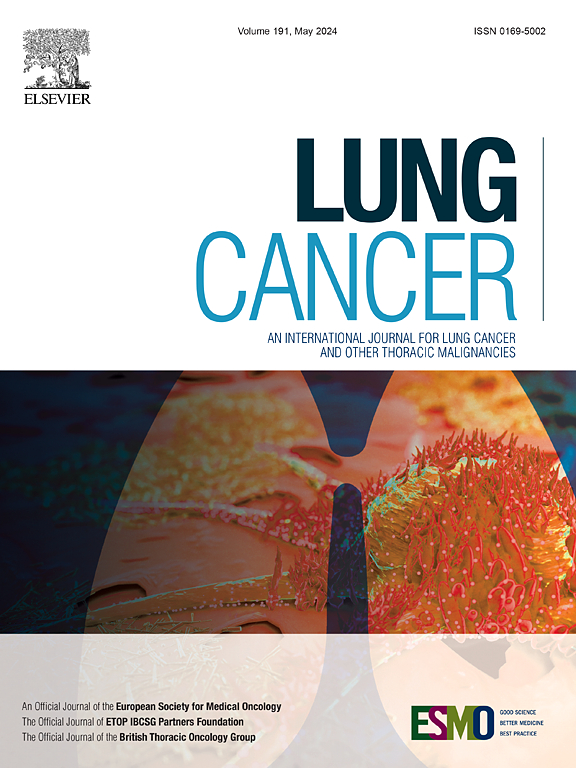Decoding KRAS mutation in non-small cell lung cancer patients receiving immunotherapy: A retrospective institutional comparison and literature review
IF 4.5
2区 医学
Q1 ONCOLOGY
引用次数: 0
Abstract
Introduction
KRAS mutation the most common molecular alteration in advanced non-small cell lung cancer (NSCLC) and is associated with an unfavourable prognosis, largely due to the lack of targeted therapeutic options for the majority of the KRAS mutated isoforms. The landscape of NSCLC treatment has expanded with the introduction of immune checkpoint inhibitors (ICIs). Nonetheless, data regarding the efficacy of ICI in NSCLC patients harbouring KRAS mutations are conflicting. This study aimed to compare clinical outcomes of ICIs in advanced NSCLC with different isoforms of KRAS mutations.
Methods
A retrospective study was conducted on 143 patients with advanced NSCLC harbouring different KRAS mutation and treated with immune checkpoint inhibitors (ICI) between December 2020 and July 2022 at “Fondazione IRCCS Istituto Nazionale dei Tumori” in Milan. Log-rank and Cox Hazard methods were used for survival analysis.
Results
We evaluated 143 patients with advanced non-small cell lung cancer (NSCLC) harboring KRAS mutations. The most common mutation was G12C (41 %), followed by G12V (23.7 %) and G12D (11.8 %). The G12C mutation was notably associated with a higher incidence of bone metastases (42 %). Immunotherapy was administered as monotherapy in 54.5 % of cases, while 69 % received it as part of a first-line combination with chemotherapy. Co-mutations were detected in 52 % of patients, with Q61 (63 %) and G12C (58 %) being the most prevalent. Among these, 24 % had STK11 co-mutations, and 29 % had TP53 co-mutations. No significant differences in overall survival (OS) or progression-free survival (PFS) were observed across different KRAS subtypes. The longest OS was seen in patients with Q61 (46.5 months), 13X (31.8 months), and G12C (28.7 months). The highest overall response rate (ORR) of 73 % was observed in the G12D group, particularly with the combination of chemoimmunotherapy, where stable disease was the most common outcome at 40 %. The median duration of response (DOR) was 7.4 months across both treatments. The longest DOR was seen in the G12V group at 10.2 months, with no significant difference between treatments. In contrast, the shortest DOR was in the G12A group, with 1.54 months in those treated with combination therapy compared to 2.57 months with single-agent therapy. Regarding co-mutations, patients with STK11 co-mutations had a higher median OS than those without (39.7 vs. 26.1 months), but this was not statistically significant (p = 1). Similarly, TP53 co-mutations were associated with a lower median OS (19.1 vs. 26.1 months, p = 0.7), though this too was not statistically significant. Importantly, bone metastases emerged as a significant adverse prognostic factor, nearly doubling the risk of mortality (HR: 2.81, p < 0.001), regardless of KRAS subtype or co-mutation status.
Conclusion
KRAS mutation subtypes demonstrate varying clinical outcomes. Although no statistically significant differences were observed in overall survival (OS) or progression-free survival (PFS), bone metastases were identified as a significant adverse prognostic factor, nearly doubling the risk of mortality (HR: 2.72, p < 0.001) regardless of KRAS subtype or co-mutation status. These findings underscore the importance of personalized treatment approaches tailored to the genetic profiles of patients with advanced NSCLC.
在接受免疫治疗的非小细胞肺癌患者中解码KRAS突变:回顾性机构比较和文献综述。
KRAS突变是晚期非小细胞肺癌(NSCLC)中最常见的分子改变,并且与不良预后相关,主要是由于大多数KRAS突变亚型缺乏靶向治疗选择。随着免疫检查点抑制剂(ICIs)的引入,NSCLC治疗的前景已经扩大。尽管如此,关于ICI在KRAS突变的NSCLC患者中的疗效的数据是相互矛盾的。本研究旨在比较具有不同KRAS突变亚型的晚期NSCLC中ICIs的临床结果。方法:2020年12月至2022年7月,在米兰“基金会IRCCS国家肿瘤研究所”对143例携带不同KRAS突变并接受免疫检查点抑制剂(ICI)治疗的晚期非小细胞肺癌患者进行回顾性研究。生存率分析采用Log-rank法和Cox Hazard法。结果:我们评估了143例携带KRAS突变的晚期非小细胞肺癌(NSCLC)患者。最常见的突变是G12C(41%),其次是G12V(23.7%)和G12D(11.8%)。G12C突变与较高的骨转移发生率显著相关(42%)。在54.5%的病例中,免疫治疗作为单一疗法,而69%的病例接受免疫治疗作为一线联合化疗的一部分。在52%的患者中检测到共突变,其中Q61(63%)和G12C(58%)最为普遍。其中,24%的人有STK11共突变,29%的人有TP53共突变。不同KRAS亚型的总生存期(OS)或无进展生存期(PFS)无显著差异。最长的生存期为Q61(46.5个月)、13X(31.8个月)和G12C(28.7个月)。在G12D组中观察到最高的总缓解率(ORR)为73%,特别是在化学免疫治疗的联合治疗中,稳定的疾病是最常见的结果,占40%。两种治疗的中位反应持续时间(DOR)为7.4个月。G12V组DOR最长,为10.2个月,两组间无显著差异。相比之下,G12A组DOR最短,联合治疗组为1.54个月,而单药治疗组为2.57个月。在共突变方面,STK11共突变患者的中位生存期高于无STK11共突变患者(39.7 vs. 26.1个月),但无统计学意义(p = 1)。同样,TP53共突变患者的中位生存期较低(19.1 vs. 26.1个月,p = 0.7),但也无统计学意义(p = 1)。重要的是,骨转移成为一个重要的不良预后因素,几乎使死亡风险增加一倍(HR: 2.81, p)。尽管在总生存期(OS)或无进展生存期(PFS)方面没有观察到统计学上的显著差异,但骨转移被认为是一个重要的不良预后因素,几乎使死亡风险增加一倍(HR: 2.72, p
本文章由计算机程序翻译,如有差异,请以英文原文为准。
求助全文
约1分钟内获得全文
求助全文
来源期刊

Lung Cancer
医学-呼吸系统
CiteScore
9.40
自引率
3.80%
发文量
407
审稿时长
25 days
期刊介绍:
Lung Cancer is an international publication covering the clinical, translational and basic science of malignancies of the lung and chest region.Original research articles, early reports, review articles, editorials and correspondence covering the prevention, epidemiology and etiology, basic biology, pathology, clinical assessment, surgery, chemotherapy, radiotherapy, combined treatment modalities, other treatment modalities and outcomes of lung cancer are welcome.
 求助内容:
求助内容: 应助结果提醒方式:
应助结果提醒方式:


